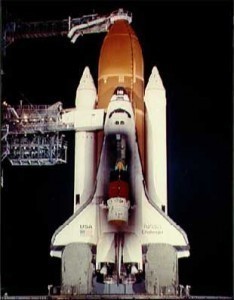Space Shuttle Challenger Dimensions
The size of the Space Shuttle Challenger was 57 ft (height), and 121 ft (length).  The wingspan was 78 ft. The empty weight was 155,400 lbs (70,489 kg). With the engines, the weight went up to 175,111 lbs or (79,430 kg. The top speed was 17,500 mph.
The wingspan was 78 ft. The empty weight was 155,400 lbs (70,489 kg). With the engines, the weight went up to 175,111 lbs or (79,430 kg. The top speed was 17,500 mph.
Other Characteristics of the Challenger
The first flight took place on April 4, 1983 and the last one was January 28, 1986 when it exploded. The Space Shuttle Challenger deployed 10 satellites and made 995 orbits. It performed a total of 10 missions and spent 62.41 days in space. The Challenger traveled a total of 25,803,939 miles.
The Challenger was able to carry 2,600 lbs (1,100 kg) more than the previous shuttle, the Columbia. The size of the Space Shuttle Challenger aside, the shuttle was also noted for being the first to employ a head up display at the descent stage.
Challenger Missions and Accomplishments
During its time the Challenger was the most widely utilized of all NASA’s shuttles. From 1983-84, the shuttle conducted nearly 85% of all shuttle space explorations.
The Challenger became the first spacecraft to put a woman into space. It was also the first to conduct a night launch and landing. The Challenger was also the first spacecraft to be destroyed while on a mission.
The April 5, 1983 Challenger mission was noted for the first spacewalk done in space. The capacity and size of the Space Shuttle Challenger allowed it to set up the TDRS-A. The mission lasted 5 days 23 min and 42 seconds.
The second mission was on June 18, 1983 and lasted for 6 days, 2 hours, 23 min and 59 seconds. It was made memorable for the presence of Sally Ride, the first American woman in space.
Its third mission was on August 30, 1983. The mission featured Guion Bluford, the first African American in space. It was also the first night launch / landing of a space shuttle. The fourth mission took place on February 3, 1984 and noted for the first untethered spacewalk. The mission lasted for one week.
The fifth (April 6, 1984) involved the Solar Maximum Service mission. The size of the Space Shuttle Challenger allowed it to deploy the Earth Radiation Budget Satellite on its sixth mission (October 5, 1984).
The mission was also noted for carrying two women and the first Canadian in space (Marc Garneau). Kathryn Sullivan became the first female to perform a spacewalk.
The 7th mission had the Challenger deploying the Spacelab 3 (April 29, 1985). The 8th mission carried the Spacelab 2 (July 29, 1985). The 9th mission carried the Spacelab D-1 (October 30, 1985).
Loss of the Challenger
The Challenger’s tenth mission was on January 28, 1986. Upon launch, the Challenger exploded, killing all seven astronauts onboard.
In the end, it was not the size of the Space Shuttle Challenger that people will remember the most. It would be its accomplishments. Several firsts were attained by the spacecraft, for which it would never be forgotten.





